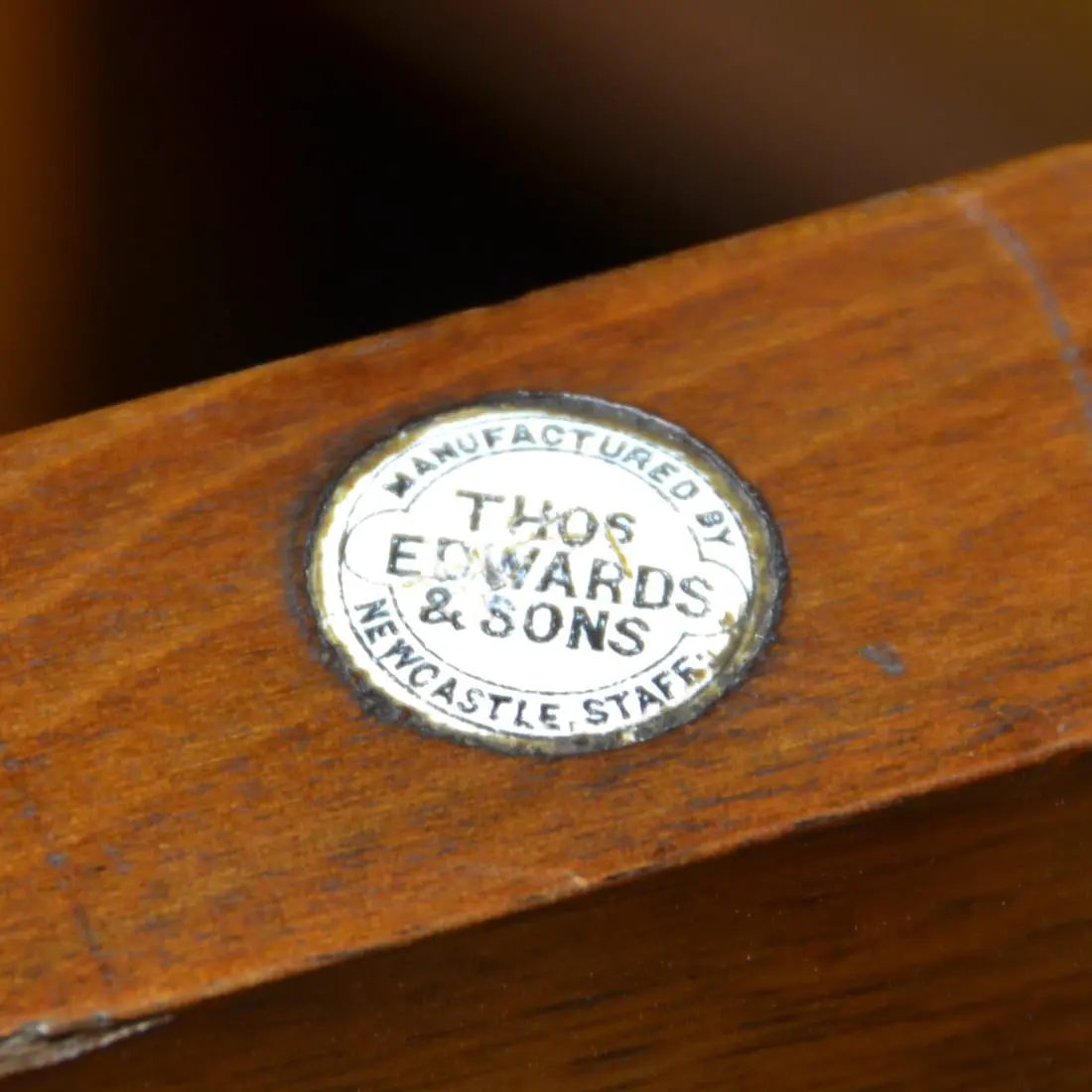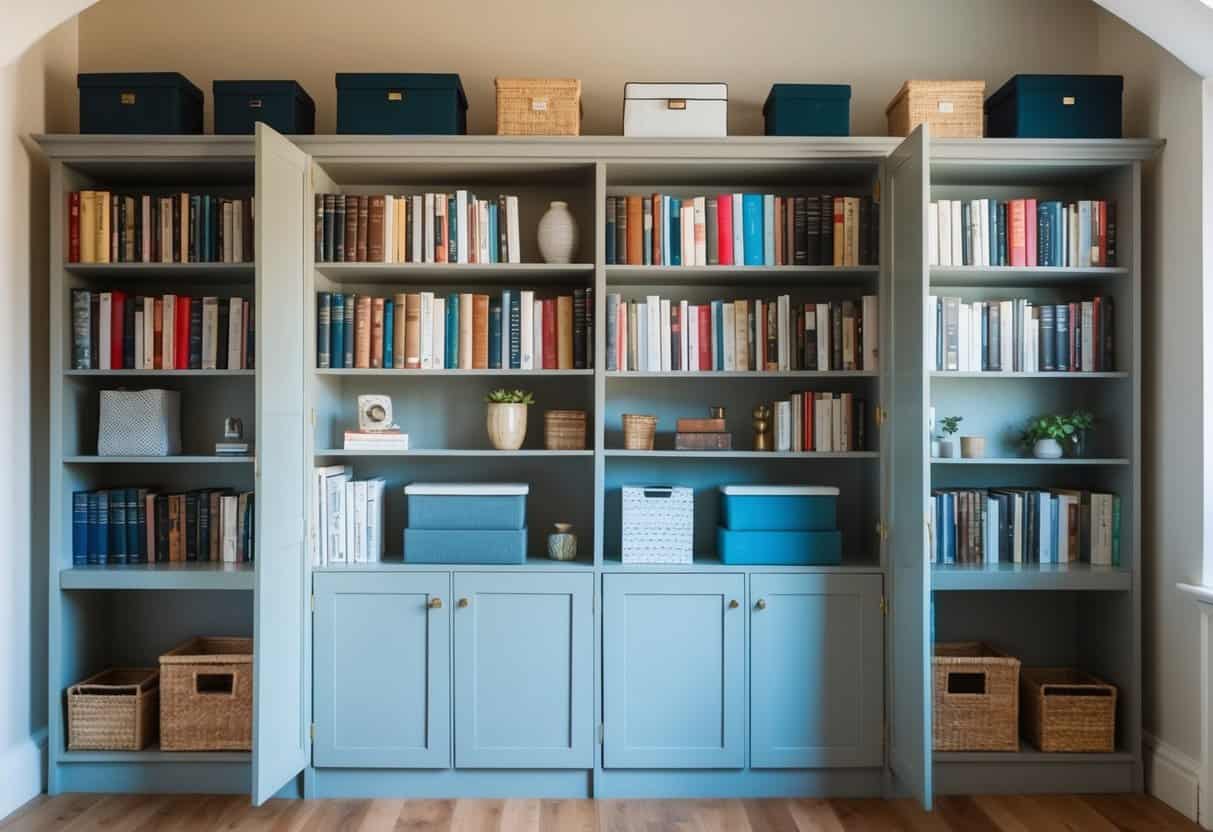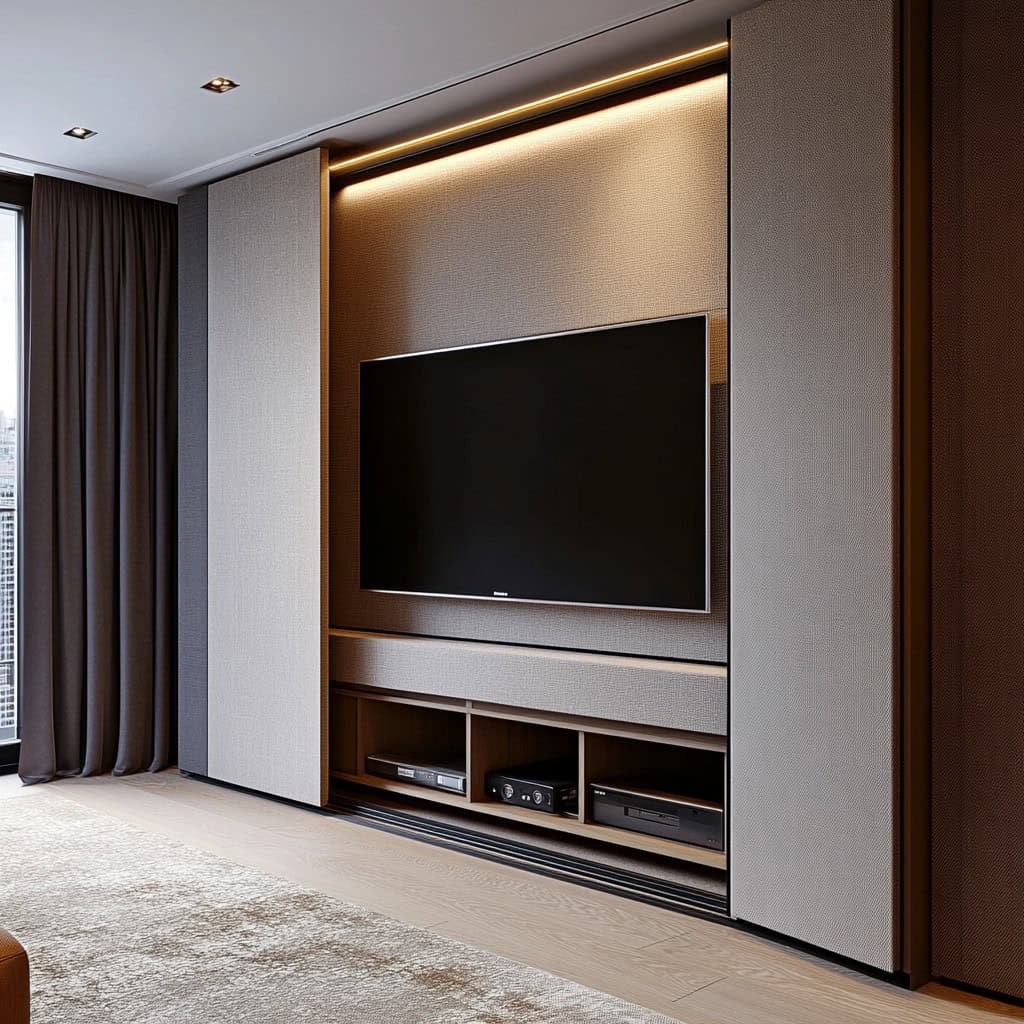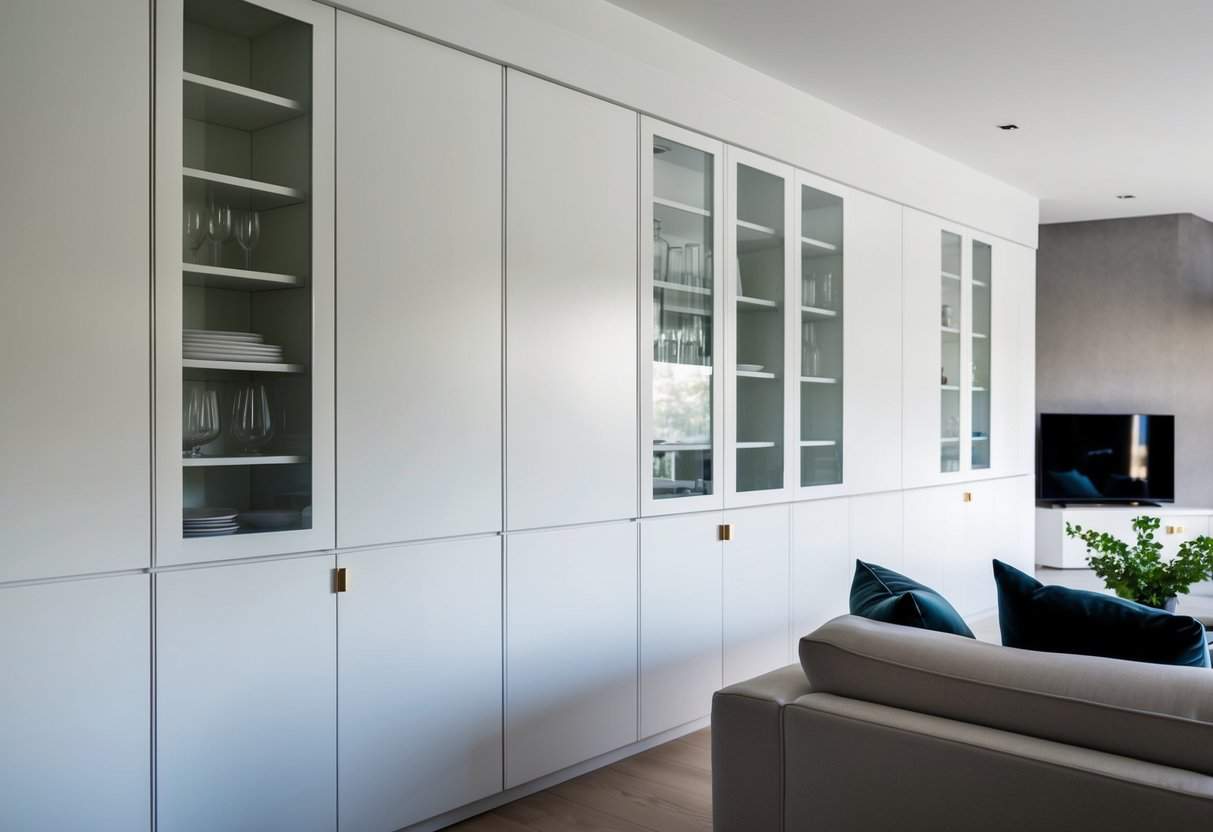Cabinet making has a rich history, with some craftsmen achieving legendary status due to their skill and innovation.
In the 18th and 19th centuries, English artisans like Thomas Chippendale and Arthur Blain set high standards with their exquisite designs and meticulous craftsmanship.
These figures not only created beautiful pieces but also influenced the styles and techniques of their peers and future generations.

You can see the elegance of classical furniture in museums and grand homes.
Frederick Tibbenham is another notable name, celebrated for his detailed work and contribution to British furniture making.
Each of these artisans brought their unique touch to the trade, ensuring that their work remains valued and studied.
From England to Scotland, regions had their unique styles and preferred materials.
Cabinet makers like A. Gardner & Son marked their names with distinctive designs.
In today’s market, appreciating these historical pieces means understanding their origins and the craftsmen behind them.
Key Takeaways
- Cabinet making has a rich history with influential figures like Thomas Chippendale.
- Different regions contributed unique styles and materials to cabinet making.
- Historical pieces by renowned cabinet makers are still valued today.
Historical Development of Cabinet Making

Cabinet making has a rich history influenced by various art and design movements. These shifts have shaped the designs and techniques used by cabinet makers over the centuries.
Gothic Influences on Furniture Design
During the Gothic period, furniture took on a distinct style characterised by intricate carvings and pointed arches. Oak was widely used due to its durability.
Cabinet makers focused on creating pieces that had both functional and decorative qualities. You would find detailed tracery and motifs inspired by Gothic architecture.
Cabinets often had a majestic and imposing presence, reflecting the grandeur of Gothic buildings and practices.
Rococo and Neoclassicism: Stylistic Evolution
The Rococo style emerged in the early 18th century, marked by its ornate and elaborate designs. Furniture pieces became lighter and more decorative.
Cabinet makers like George Hepplewhite and Thomas Chippendale were known for their elegant and playful designs that included floral motifs and curving forms.
Neoclassicism followed, bringing a return to classical simplicity and symmetry.
This period saw straight lines and more restrained ornamentation.
Cabinet makers incorporated elements like columns and pilasters, giving furniture a dignified and balanced appearance.
19th Century Innovations in Furniture
The 19th century was a period of significant innovation in cabinet making.
Advances in machinery allowed for mass production and more intricate designs.
Designers like George Smith and firms like Seddon & Sons expanded their range of products.
This period saw the rise of styles like Victorian and Arts and Crafts.
Victorian furniture was known for its heavy ornamentation and dark wood, while the Arts and Crafts movement emphasised handcrafted quality and simple forms.
Cabinet makers adapted to changing tastes and technologies, making furniture more accessible to a growing middle class.
Prominent Cabinet Makers and Designers
This section explores key figures in cabinet making who shaped styles and influenced furniture design. Each person’s unique contributions are highlighted, showcasing their impact on craftsmanship and antique furniture.
Thomas Chippendale and the Chippendale Style
Thomas Chippendale was an esteemed furniture designer from London.
His work in the mid-Georgian era produced the renowned Chippendale style, which combined English Rococo and Neoclassical elements.
In 1754, he published “The Gentleman and Cabinet Maker’s Director,” a book immortalising his designs. It became a significant collection, setting trends in furniture pieces across England.
His pieces were known for their intricate carvings and exquisite craftsmanship, often featuring lion’s paw feet or rocaille ornamentation.
The Artistic Legacy of André-Charles Boulle
André-Charles Boulle was a master cabinet maker in France during the late 17th and early 18th centuries.
Boulle is famous for his marquetry technique, called “Boulle work,” which used inlays of brass and tortoiseshell to create ornate patterns on furniture.
His craftsmanship was highly detailed, making each piece a work of art.
Boulle’s designs were often grand and luxurious, and they remain influential in antique furniture. His legacy continues to define high-quality cabinet making and marquetry.
Neoclassical Elegance: Robert Adam’s Contributions
Robert Adam, a prominent furniture designer, is known for his Neoclassical style.
In the 18th century, Adam’s approach to furniture design emphasised classical simplicity and elegance.
His designs often featured clean lines, symmetry, and references to classical architecture.
Adam collaborated with skilled craftsmen to create furniture that perfectly complemented his architectural projects.
His work had a significant impact, influencing the aesthetic of British interior design and marrying architecture with detailed, harmonious furniture pieces.
Thomas Sheraton’s Furniture Philosophy
Thomas Sheraton was an influential English furniture designer at the turn of the 19th century.
His style marked a move towards lighter, more delicate forms.
Sheraton authored “The Cabinet Dictionary” and “The Cabinet Maker and Upholsterer’s Drawing Book,” where he outlined his design philosophy.
He preferred straight lines and simple, elegant shapes.
Sheraton’s craftsmanship placed an emphasis on practicality and refinement. His designs remain important in understanding the evolution of antique furniture and the transition to more modern aesthetics.
Cabinet Making Techniques and Materials
Cabinet making involves a variety of techniques and materials, each contributing to the beauty and quality of the final piece.
From the rich use of mahogany to intricate marquetry and gilding, the craftsmanship in reputable furniture design is truly impressive.
The Role of Mahogany in Furniture Making
Mahogany is a highly prized material in cabinet making due to its durability and attractive grain.
This hardwood is known for its deep, reddish-brown colour that deepens over time. Its fine grain allows for a smooth finish, making it ideal for high-quality furniture.
In the 18th and 19th centuries, mahogany became a favourite among British cabinet makers for crafting elegant pieces such as tables, chairs, and cabinets.
Its resistance to swelling, shrinking, and warping ensures longevity, making it a staple in antique and luxury furniture design even today.
Marquetry and Inlay: Masters of Details
Marquetry is the art of applying pieces of veneer to create decorative patterns on furniture.
This technique involves cutting and fitting small, intricate pieces of wood, metal, or other materials.
It requires incredible precision and skill, setting apart master craftsmen from the rest.
Inlay, on the other hand, involves setting materials into the surface of the wood.
Commonly used alongside marquetry, inlay can include materials such as ivory, brass, and mother-of-pearl.
Both techniques add a layer of sophistication and detail to the furniture, making each piece unique.
Historic cabinet makers renowned for marquetry and inlay include Thomas Chippendale and André-Charles Boulle.
Gilding and Ornamentation in Cabinet Making
Gilding involves applying a thin layer of gold leaf or gold paint to furniture surfaces.
This technique adds a luxurious touch to cabinets, mirrors, and other decorative items.
The process can be meticulous, often requiring multiple layers for a rich, gleaming finish.
Gilded furniture is often associated with opulence and has been used extensively in palatial and high-end designs.
Ornamental carvings and gilding were especially popular in the Baroque and Rococo periods, highlighting the intricate craftsmanship of cabinet makers who could transform ordinary wood into works of art. Holkham Hall houses some notable examples of this exquisite gilding and ornamentation.
Cabinet Making Through the Centuries
Cabinet making has evolved significantly from the intricate designs of French artisans to the refined elegance of British craftsmen. These changes highlight the influence of cultural and historical contexts on furniture design.
Cabinet Making in the French Tradition
French cabinet making is renowned for its opulent and intricate designs.
Paris became a hub for this art form during the 18th century, with master craftsmen like Charles Cressent and André-Charles Boulle leading the way.
Cressent was known for his elaborate gilt bronzes, while Boulle perfected marquetry with wood and brass inlays.
These cabinetmakers often combined their skills with those of sculptors and upholsterers to create stunning works. Their designs featured intricate carvings and luxurious materials. This legacy of detailed craftsmanship continues to be celebrated today.
British Cabinet Making Heritage
British cabinet makers like Thomas Chippendale and Thomas Sheraton have left a lasting legacy.
Chippendale’s work in the mid-1700s brought a blend of Gothic, Rococo, and Chinese influences, making his designs timeless classics.
Sheraton, who followed, introduced a more refined and elegant style, marked by straight lines and minimal ornamentation.
Manchester and other British cities became centres of high-quality cabinet making.
British designs were often more subdued compared to their French counterparts but were equally valued for their craftsmanship and practicality.
This tradition has set a standard for functional yet stylish furniture that continues to influence modern designs.
Cabinet Making in the Modern Context
Modern cabinet making continues to evolve with a focus on both traditional craftsmanship and contemporary design.
You will find innovative workshops that balance age-old techniques with new materials and methods.
Workshops and Apprenticeships
In today’s world, many workshops still follow traditional apprenticeship models. This allows new designers to learn directly from experienced cabinet makers.
You might hear about Catherine Redshaw, who trains young artisans in both classic and modern techniques.
These workshops don’t just create furniture; they foster a culture of craftsmanship.
They use tools ranging from hand saws to CNC machines, blending precision with artistry.
Hands-on training ensures the continuation of high standards in furniture design.
The Global Influence of Cabinet Makers
Cabinet makers have a significant impact globally, influencing styles and trends far beyond their own regions.
European designers like Auguste Pottier introduced ornate styles that spread across continents.
Similarly, American styles by William Stymus featured bold, intricate designs.
You can see their influence in modern furniture pieces worldwide—from elegant sofas to functional dining chairs.
Contemporary cabinet makers often draw inspiration from these historical figures, ensuring their legacy continues.
Notable Cabinets and Furniture Pieces
Some furniture pieces created by cabinet makers stand out for both their design and craftsmanship.
Famous pieces might include elaborate display cabinets or intricately carved dining tables.
You can find such works in museums, private collections, and high-end furniture stores.
These notable pieces often feature detailed inlays, impressive joinery, and a blend of materials like wood and metal.
The effort and artistry involved make them not just functional items, but also works of art that reflect the skills of their creators. This blend of utility and beauty is what sets exceptional cabinets and furniture pieces apart.
Cabinet Making in Popular Culture
Cabinet making has a significant presence in popular culture. This is seen through iconic furniture placed in public spaces, prestigious museum exhibits, and detailed representations in media and literature.
Iconic Furniture in Public Spaces
In many public spaces, you can find well-known pieces of furniture designed by famous cabinet makers. The White House features furniture by Thomas Chippendale. His designs combine elegance and craftsmanship that reflect the cultural heritage of the 18th century.
Hotels like the Plaza Hotel are home to beautiful antique pieces. This makes these places not just accommodations but also showcases of historical furniture design.
Furniture as Museum Pieces
Furniture crafted by master cabinet makers often earns a place in prestigious museums. At the Victoria and Albert Museum, you can see pieces by great English cabinet makers from the 18th and 19th centuries. These exhibits highlight the intricate designs and high levels of skill from that era.
Likewise, Holkham Hall displays remarkable works. This allows visitors to appreciate the artistic and functional brilliance of historical furniture. These collections bring historical and cultural insights into cabinet making traditions.
Representation in Media and Literature
Media and literature often highlight cabinet making, exploring its techniques and historical figures. Books and articles delve into the lives and works of cabinet makers like William Ince and John Mayhew, who were highly influential in their time.
Meanwhile, films and series also feature cabinet making. These portrayals help the audience understand the craft and its importance. Such representation makes the discipline more accessible and appreciated by a broader audience who might otherwise overlook the intricacy of furniture design and construction.
Regional Styles and Influences
The world of furniture has seen many regional styles and influences. Notable examples include Chinese-inspired designs in Western furniture, exquisite craftsmanship from Italy’s Turin school, and the unique legacy of American craftsmanship.
Chinese Influences on Western Furniture
In the 18th century, Western furniture makers were greatly inspired by Chinese design. This movement, known as Chinoiserie, brought exotic elements into European homes.
Cabinet makers created pieces with lavish motifs such as pagodas, dragons, and floral patterns. Chinese lacquer techniques became widespread, introducing a glossy, durable finish. Artists used bold colours like red, gold, and black.
Elaborate screens, cabinets, and chairs featured intricate carvings and were highly sought after.
Major European figures like Thomas Chippendale famously embraced these influences. His designs often included Chinese fretwork and oriental scenes, blending Eastern and Western aesthetics.
Italian Craftsmanship: The Turin School
Italy, especially Turin, has been a cornerstone of exquisite furniture craftsmanship. Known for its elegant and detailed work, Turin’s furniture often showcases intricate marquetry, inlay, and gilding.
Meanwhile, the Turin craftsmen were skilled in working with fine woods such as walnut and cherry. Their designs included elegant curves, detailed carvings, and luxurious finishes. Turin’s style merged functionality with aesthetics, making their furniture both beautiful and practical.
Renowned cabinet makers from Turin influenced European furniture styles. Their dedication to quality and artistry is evident in the elaborate wardrobes, sophisticated tables, and graceful chairs they produced.
American Craftsmanship and Legacy
American furniture makers have developed a distinctive style that combines practicality with elegance. The Shaker movement, for instance, emphasised simplicity and functionality.
Shaker furniture features clean lines, minimalistic designs, and sturdy construction.
Then, the 19th century saw the rise of craftsmen like Duncan Phyfe, who introduced refined neoclassical styles. Phyfe’s works are known for their symmetry, fine veneers, and elegant details. His influence extended beyond the United States, shaping furniture trends globally.
The American Arts and Crafts movement also left a significant legacy. It focused on traditional craftsmanship, using natural materials and simple, handcrafted designs. This period produced enduring classics that remain popular today.
The Business of Cabinet Making
Cabinet making in the 18th and 19th centuries involved intricate craftsmanship and strong connections with patrons and subscribers. These relationships were crucial for both the design and sale of furniture.
The Role of Patrons and Subscribers
Patrons played a key role in the success of cabinet makers. Wealthy individuals or families often commissioned custom designs, allowing designers to showcase their skills and creativity.
These patrons not only financed the production of high-quality furniture but also elevated the reputation of the craftsmen they supported.
Meanwhile, subscribers were another important aspect of this business. Often, a group of wealthy customers would pre-commit to purchasing a series of furniture pieces.
This guaranteed sales, helping cabinet makers plan and allocate resources more effectively. The commitment from subscribers gave designers the financial stability to produce innovative and high-quality work.
Famous designers like George Smith, who worked for the Royal Family, relied heavily on these networks. His title “upholder extraordinary” indicates the high level of trust and esteem patrons placed in him, allowing him to create influential designs that shaped the era. For more information about George Smith, visit the Furniture History Society.
Cabinet Making Conservation and Restoration
Conserving and restoring antique furniture requires a deep knowledge of craftsmanship, materials, and historical designs. Effective techniques ensure the original character and integrity of each piece is preserved.
Techniques in Preserving Antique Furniture
French Polishing: This technique involves applying many thin layers of shellac to create a high-gloss finish. It’s labour-intensive but provides a beautiful, durable surface that highlights the wood’s grain.
Gilding: This process covers parts of the furniture with gold leaf. It’s used to restore or enhance decorative elements, giving the piece a luxurious appearance.
Veneering and Inlay Work: Repairing or adding thin layers of wood veneer, and intricate inlays can restore damaged surfaces and give new life to the furniture. These techniques require precision and skill.
Joinery: High-quality joinery repairs, such as fixing loose joints or replacing broken parts, ensure the structural integrity of the piece. Specialists use traditional methods to match the original craftsmanship.
Specialist craftsmen like those at Tony Vernon Antique Furniture provide these services, preserving the beauty and history of antique furniture.
Frequently Asked Questions
Understanding the key figures and identifying marks in cabinet making history helps appreciate the craftsmanship behind these timeless pieces.
Who were the prominent cabinet makers during the 18th century?
Thomas Chippendale and William Grene were key figures in the 18th century. Chippendale’s intricate carvings and detailed designs set a benchmark. Meanwhile, Grene was noted for his work for Henry VIII, crafting complex pieces with fine materials.
Can you name some renowned furniture makers from the 19th century in England?
Thomas Chippendale continued his influence into the 19th century. Other notable names include Arthur Blain, who established his workshop in Liverpool in 1835, and A. Gardner & Son from Glasgow, known for their high-quality craftsmanship.
Why does Thomas Chippendale hold a significant place in furniture making history?
Thomas Chippendale published “The Gentleman and Cabinet-Maker’s Director,” which popularised his style. His designs are famous for their elegance and intricate detail, influencing many other cabinet makers and establishing him as a pivotal figure in furniture design.
What are the indications of authenticity found on furniture crafted by eminent makers?
Authentic furniture pieces by eminent makers often bear specific marks or labels. For example, Chippendale’s pieces might show particular stylistic traits like intricate carvings and tight joinery. Meanwhile, provenance and historical records can also verify authenticity.
Which cabinet makers are pivotal in the history of furniture design?
Apart from Thomas Chippendale, Pietro Piffetti from Italy is another significant figure. His craftsmanship in the 18th century set high standards in cabinet making, known for using fine materials and innovative designs.
How does one identify the marks of illustrious 20th-century furniture makers?
To identify 20th-century furniture makers, look for labels, signatures, or stamps. These marks often include the maker’s name and sometimes the place of manufacture. Careful attention to craftsmanship details, like joinery and finish, also helps.










